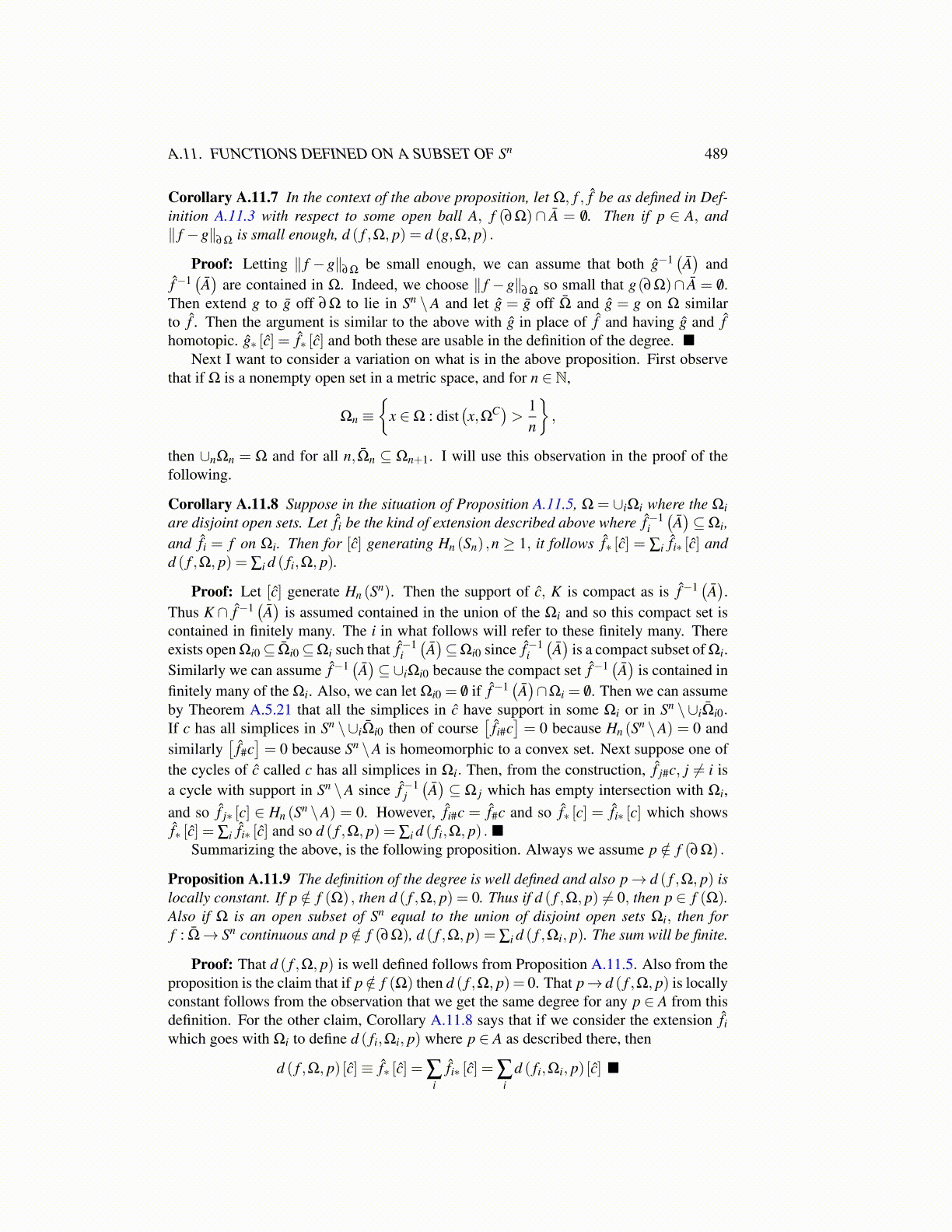
A.11. FUNCTIONS DEFINED ON A SUBSET OF Sn 489
Corollary A.11.7 In the context of the above proposition, let Ω, f , f̂ be as defined in Def-inition A.11.3 with respect to some open ball A, f (∂Ω)∩ Ā = /0. Then if p ∈ A, and∥ f −g∥
∂Ωis small enough, d ( f ,Ω, p) = d (g,Ω, p) .
Proof: Letting ∥ f −g∥∂Ω
be small enough, we can assume that both ĝ−1(Ā)
andf̂−1(Ā)
are contained in Ω. Indeed, we choose ∥ f −g∥∂Ω
so small that g(∂Ω)∩ Ā = /0.Then extend g to ḡ off ∂Ω to lie in Sn \A and let ĝ = ḡ off Ω̄ and ĝ = g on Ω similarto f̂ . Then the argument is similar to the above with ĝ in place of f̂ and having ĝ and f̂homotopic. ĝ∗ [ĉ] = f̂∗ [ĉ] and both these are usable in the definition of the degree. ■
Next I want to consider a variation on what is in the above proposition. First observethat if Ω is a nonempty open set in a metric space, and for n ∈ N,
Ωn ≡{
x ∈Ω : dist(x,ΩC)> 1
n
},
then ∪nΩn = Ω and for all n,Ω̄n ⊆ Ωn+1. I will use this observation in the proof of thefollowing.
Corollary A.11.8 Suppose in the situation of Proposition A.11.5, Ω = ∪iΩi where the Ωiare disjoint open sets. Let f̂i be the kind of extension described above where f̂−1
i
(Ā)⊆Ωi,
and f̂i = f on Ωi. Then for [ĉ] generating Hn (Sn) ,n ≥ 1, it follows f̂∗ [ĉ] = ∑i f̂i∗ [ĉ] andd ( f ,Ω, p) = ∑i d ( fi,Ω, p).
Proof: Let [ĉ] generate Hn (Sn). Then the support of ĉ, K is compact as is f̂−1(Ā).
Thus K ∩ f̂−1(Ā)
is assumed contained in the union of the Ωi and so this compact set iscontained in finitely many. The i in what follows will refer to these finitely many. Thereexists open Ωi0⊆ Ω̄i0⊆Ωi such that f̂−1
i
(Ā)⊆Ωi0 since f̂−1
i
(Ā)
is a compact subset of Ωi.Similarly we can assume f̂−1
(Ā)⊆∪iΩi0 because the compact set f̂−1
(Ā)
is contained infinitely many of the Ωi. Also, we can let Ωi0 = /0 if f̂−1
(Ā)∩Ωi = /0. Then we can assume
by Theorem A.5.21 that all the simplices in ĉ have support in some Ωi or in Sn \∪iΩ̄i0.If c has all simplices in Sn \∪iΩ̄i0 then of course
[f̂i#c]= 0 because Hn (Sn \A) = 0 and
similarly[
f̂#c]= 0 because Sn \A is homeomorphic to a convex set. Next suppose one of
the cycles of ĉ called c has all simplices in Ωi. Then, from the construction, f̂ j#c, j ̸= i isa cycle with support in Sn \A since f̂−1
j
(Ā)⊆ Ω j which has empty intersection with Ωi,
and so f̂ j∗ [c] ∈ Hn (Sn \A) = 0. However, f̂i#c = f̂#c and so f̂∗ [c] = f̂i∗ [c] which showsf̂∗ [ĉ] = ∑i f̂i∗ [ĉ] and so d ( f ,Ω, p) = ∑i d ( fi,Ω, p) . ■
Summarizing the above, is the following proposition. Always we assume p /∈ f (∂Ω) .
Proposition A.11.9 The definition of the degree is well defined and also p→ d ( f ,Ω, p) islocally constant. If p /∈ f (Ω) , then d ( f ,Ω, p) = 0. Thus if d ( f ,Ω, p) ̸= 0, then p ∈ f (Ω).Also if Ω is an open subset of Sn equal to the union of disjoint open sets Ωi, then forf : Ω̄→ Sn continuous and p /∈ f (∂Ω), d ( f ,Ω, p) = ∑i d ( f ,Ωi, p). The sum will be finite.
Proof: That d ( f ,Ω, p) is well defined follows from Proposition A.11.5. Also from theproposition is the claim that if p /∈ f (Ω) then d ( f ,Ω, p) = 0. That p→ d ( f ,Ω, p) is locallyconstant follows from the observation that we get the same degree for any p ∈ A from thisdefinition. For the other claim, Corollary A.11.8 says that if we consider the extension f̂iwhich goes with Ωi to define d ( fi,Ωi, p) where p ∈ A as described there, then
d ( f ,Ω, p) [ĉ]≡ f̂∗ [ĉ] = ∑i
f̂i∗ [ĉ] = ∑i
d ( fi,Ωi, p) [ĉ] ■